Stars come out for The Big Franklin Book
Whitehorse & Sudbury papers light way to solving mystery
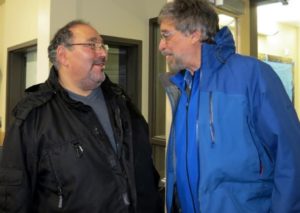
By Dan Davidson / Whitehorse Star
Ken McGoogan has been fascinated, one might even say obsessed, with the history of Arctic exploration, especially as it relates to Sir John Franklin, and to those explorers who pursued what Pierre Berton called The Arctic Grail in his book on that subject.
McGoogan was a welcome guest at the Berton House Writers’ Retreat in the fall of 2002, the year after he published Fatal Passage: The Story of John Rae, the Arctic Hero that Time Forgot.
He spent his time here working on his next project, a biography of an even earlier explorer, Samuel Hearne.
While he does tackle other subjects, he keeps circling back to this one.
He has produced five related books since 2001, as well as voyaging in the Arctic on Adventure Canada Cruises for more than a decade, giving talks on Arctic exploration history.
Because of this personal focus, this book combines elements of historical research with personal memoir. It was during one of these journeys through the Northwest Passage in 2017 that he was challenged by his friend, Louie Kamookak.
“When are you going to write your big Franklin book?”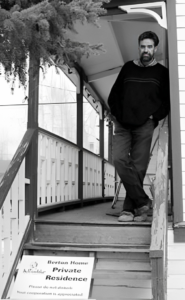
“My big Franklin book?” McGoogan replied.
“You’ve written about everybody else. Don’t you think it’s time?”
“No way,” McGoogan replied, shaking his head. “I’m still too young.”
They laughed together, and six months later, Kamookak, who had spent much of his life in search of Franklin’s grave vault, died.
Another book, McGoogan’s second related to the migrations of the Celts and the Highlanders, came first, but this one was on the back burner.
When he settled down to his keyboard, he found that a lot of the work on the previous four had given him relevant source material.
He cites numerous other pieces of research that were useful, and it was interesting to find that Dr. Peter Steele’s book about Franklin’s lieutenant, George Back (The Man Who Mapped the Arctic), was of particular use in the second section of this book.
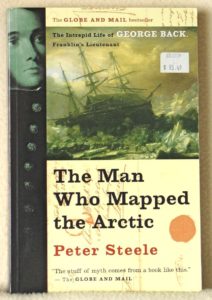
Franklin had a varied career, but McGoogan focuses on his Arctic expeditions, all of which really do seem to have suffered from his inability to learn from and work with the Indigenous inhabitants.
He paints Franklin as a man handicapped by a failure to appreciate the strengths of anyone who wasn’t of his English class, and further limited by his extreme adherence to his version of the Christian faith, which caused him to value prayer and the intervention of the divine over the need for sound planning and preparation.
That he ought to have paid more attention to the First Nation and Inuit people is somewhat born out by the fact that, when the wrecks of the Terror and the Erebus were found, they were located close to where the Inuit oral tradition indicated they were last seen.
The book is organized in five sections, six if you include the prologue, “The Myth of the Explorer”, which deals somewhat with the hagiography Lady Franklin encouraged.
Part One, “The Search for Franklin”, provides an overview of the decades-long mystery and the attempts to solve it.
“The Royal Navy Man” establishes his training and his need to stick to it.
“Haunting the Land” examines some of the attempts to figure out just what went wrong and introduces us to some the people McGoogan has met while trying to figure things out, as well as advancing various theories.
“The True Believer” gives us the man who trusts in Providence to provide and takes us up to the time and place where at least one person was eaten, though probably not by Franklin.
“Interweaving Expeditions” advances yet another theory, probably the best one, as to just what killed the crew on that final expedition.
I’m not going to spoil the reveal by telling you what it is – but it’s pretty convincing.
The epilogue is sort of a thank you letter to Kamookak, who has been referred to from time to time in the book and whose ribbing comment inspired McGoogan to begin writing it.
This section ends with the memory of the time, in 1999, when he and Kamookak, along with Cameron Treleaven, carried a special plaque and a heavy stand to erect at the spot where John Rae realized he had found the actual Northwest Passage.
The plaque reads, “This plaque marks the spot where Arctic explorer John Rae (1813 to 1893) discovered the final link in the Northwest passage.”
Rae found what Franklin had not, and reported back that the bodies he had found gave every indication there had been cannibalism.
For bringing this unwelcome news back to England, he was attacked by Lady Franklin and pilloried by no less than Charles Dickens.
Time would prove him to have been correct.
Dan Davidson is a newspaper correspondent based in Dawson City.
***
By Bonnie Kogos / Sudbury Star
Last October, I read online that a best-selling Canadian author would be doing 15 CBC Radio interviews in a single day, including one for Sudbury’s Up North with Jonathan Pinto. Amazing.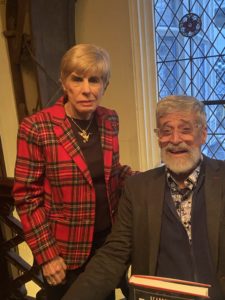
In his latest adventure, beautifully described in the new book, Searching for Franklin, Ken McGoogan told us how, in 1999, he went rambling around the Arctic with the late Louie Kamookak, a famous Inuit oral historian. Ah, I could ramble with them if I read the book. And I got the book.
Ken McGoogan was in New York City this month to lecture and share his delight in his newest work, Searching for Franklin at the prestigious Explorers Club and the New York Public Library.
I plunged into Searching for Franklin and was captivated. Suddenly, I was cold, curious and needing to explore the amazing, terrifying Arctic with the author’s first-hand accounts of visiting historical locations.
He described voyaging with Adventure Canada and landing on Beechey Island, where he visited the gravesites of the first three men to die during Franklin’s last expedition.
Searching for Franklin interweaves two main stories. The first describes Franklin’s Arctic Overland Expedition of 1819, which ended in disaster. Rejecting the advice of local Dene and Metis leaders, Lt. John Franklin lost 11 of his 21 men to exhaustion, starvation and murder.
The second story focuses on that great Arctic mystery: What went wrong? Theories keep being advanced and underwater archaeologists from Parks Canada are still turning up clues. This amazing book builds on Ken’s research and personal experience. He draws on Inuit oral history and interviews he conducted with a leading Canadian epidemiologist, David Waltner-Toews, to put together a new theory about what doomed the final Franklin expedition.
 It wasn’t lead poisoning or botulism. Ken asserts that disaster struck because the sailors became sick when they ate infected polar bear meat that had not been properly cooked. This is woven into his dramatic and compelling story.
It wasn’t lead poisoning or botulism. Ken asserts that disaster struck because the sailors became sick when they ate infected polar bear meat that had not been properly cooked. This is woven into his dramatic and compelling story.
For me, a former busy travel agent and writer who’s had the luck to travel to more than 90 countries, I understand the interest and energy of Ken McGoogan and why he travels the world to do research for his writing. While I’ve booked clients to the Caribbean, Europe, around North and South America, and Canada, I’ve never been or booked anyone to travel way up into the Arctic. Now I was curious.
I phoned Douglas & McIntyre, the publisher, and got Ken’s email. I wrote him and said I would like to interview him.
He was gracious and cooperative. We would say hello at The Explorers Club in NYC. In explaining himself, Ken wrote: “Travel is not a vacation for me, but an immersion in a different time and place.”
On his website, Ken describes himself as “a globe-trotting, history-hunting storyteller who has survived a shipwreck off Dar es Salaam, Tanzania. And I’ve literally chased the ghost of Lady Jane Franklin from Russell Square in London to Van Diemen’s Land in Tasmania, as well as placed an important John Rae memorial plaque in the High Arctic.”
Writing for Postmedia News, Jamie Portman declares that this “breathtaking new book … often reads like a detective thriller. There’s a raw immediacy, a forceful current of white-knuckle suspense, to McGoogan’s recreation of events.”
It’s no surprise that Ken McGoogan is one of a small number of Canadian authors to land speaking engagements in New York City.
“Bonnie, in September, Douglas and McIntyre will publish my 17th book,” he told me. “It’s an unabashedly political work that addresses what Leonard Cohen might have called our current predicament.”
Ken told me while researching his book, Lady Franklin’s Revenge, he stayed in her former house in London. “Then I landed a gig as writer-in-residence in Tasmania and I spent several weeks exploring the island, researching locations that Sir John and Lady Franklin knew in the 1830s and 40s.
“Having grown up in a francophone town north of Montreal on Lac des Deux Montagnes,” Ken said, “I was able to teach French at an international school in Tanzania. A fellow teacher named Sam bought an old sailboat and took me and a third teacher sailing.
“An offshore wind blew up and we found ourselves far out beyond anyone else. Our novice boat owner tried to reverse course by gibing – a risky maneuver at the best of times.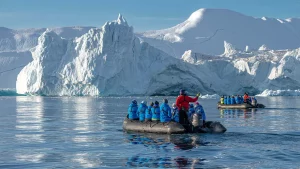
“The old mast snapped off and the boat turned over, flipping the three of us into the water. We discovered the airbags were empty and the overturned boat could support only one man without sinking. Yes, the guy who now announced that he couldn’t swim. That left me and Sam in the heaving Indian Ocean, one at the bow, one at the stern, trying to guide our upside-down boat while actively forgetting that sharks haunted these waters.
“We were lucky, working furiously for an hour. We managed to run the boat onto a tiny beach on rocky Bongoyo Island,” Ken said. “Beyond which lay the wide-open Indian Ocean. We spent the night huddled under a sail during what became the worst tropical storm in a decade. A real palm-tree-bender.
“Rescue came next morning, though people onshore had thought we were dead. And that’s how my love of adventure and learning truly began.”
Ken will return to the Arctic with Adventure Canada, sailing this summer as an ambassador for the Royal Canadian Geographical Society. He hopes to revisit the site where, 25 years ago, he placed a memorial plaque with the late Louie Kamookak.
I was also happy to meet Cedar Swan, the CEO of Adventure Canada at the Club. Her company offers amazing trips throughout the Arctic. Ken and his wife will lead one trip into the Northwest Passage this summer on one of their small ship expeditions to the Canadian High Arctic, Greenland and Atlantic Canada.
Now I’m studying the Adventure Canada travel brochure. This looks fascinating to travel in this region. Hmmm, not just to read about it …
Bonnie Kogos is a Sudbury Star columnist